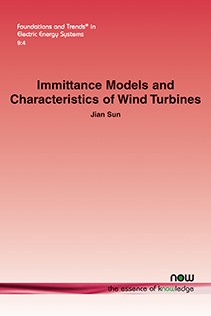Immittance Models and Characteristics of Wind Turbines
By Jian Sun, Rensselaer Polytechnic Institute, USA, jsun@rpi.edu
Abstract
Electric energy systems worldwide are undergoing a fundamental transformation because of the replacement of fossil-based power plants by generation from renewable sources such as solar and wind. Compared to conventional synchronous generators, wind and solar power generators rely on converters for integration with the grid and have very different characteristics. One of the challenges associated with converter-based generation is fast control of converters. The resulting high-frequency dynamics create new system interaction and stability problems that cannot be studied using existing methods based on fundamental-frequency (RMS-value) models. Frequency-domain models based on small-signal immittance overcome the limitations of RMS-value models, making it possible to study the stability of practical converter-based power systems.
This monograph presents the development of small-signal sequence immittance models for wind power generators, including both type-III and type-IV turbines, to support immittance-based frequency-domain stability analysis of different wind power systems. A two-level voltage source converter operating with an ideal dc source is used to introduce the concept of small-signal sequence immittance and its modeling. To include the effects of dc bus voltage dynamics, the converter is then treated as a two-port network and modeled by a set of self and transfer admittances. The two-port models are then used as building blocks and combined with induction and synchronous machine models to develop immittance models for type-III and type-IV turbines, respectively. The developed models are also used to explain the characteristics of each type of turbine and possible instability problems when connected to power systems.
Immittance Models and Characteristics of Wind Turbines
Electric energy systems worldwide are undergoing a fundamental transformation because of the replacement of fossil-based power plants by generation from renewable sources such as solar and wind. Compared to conventional synchronous generators, wind and solar power generators rely on converters for integration with the grid and have very different characteristics. One of the challenges associated with converter-based generation is fast control. The resulting high-frequency dynamics create new system interaction and stability problems that cannot be studied using existing methods based on fundamental-frequency (RMS-value) models. Frequency-domain models based on small signal immittance overcome the limitations of RMS-value models, making it possible to study the stability of practical converter-based power systems.
This monograph presents the development of small-signal sequence immittance models for wind power generators, including both type-III and type-IV turbines, to support immittance-based frequency-domain stability analysis of different wind power systems. A two-level voltage source converter operating with an ideal dc source is used to introduce the concept of small-signal sequence immittance and its modeling. To include the effects of dc bus voltage dynamics, the converter is then treated as a two-port network and modeled by a set of self and transfer admittances. The two-port models are then used as building blocks and combined with induction and synchronous machine models to develop immittance models for type-III and type-IV turbines, respectively. The developed models are also used to explain the characteristics of each type of turbine and possible instability problems when connected to power systems.
